The pandemic has not slowed the demand for high bandwidth, high-performance systems, such as 56 Gbps PAM4, 112 Gbps PAM4 and more. Designer engineers in all types of industries, from data center, HPC, networking, telecom, medical, storage, semiconductor, wireless, test and measurement, automation and security, to name a few, continue to develop architectures to accommodate the seemingly insatiable demand for data.
Earlier this year, when we were participating in live conferences and exhibitions, Samtec showed several live product demonstrations of 56 Gbps and 112 Gbps PAM4 systems operating with outstanding performance. Here’s a quick summary of the demos that caught the most attention.
A 70 GHz High-Performance Test Solution
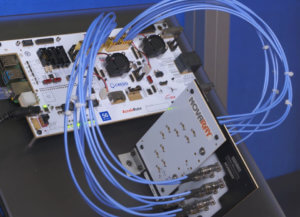
First is a live product demonstration of a 70 GHz, high-performance test point system. This demo incorporates a Credo Bald Eagle 2 retimer transmitting QPRBS31 pattern signals at 56 Gbps PAM4 data rates on five separate channels, as well as showcasing two new high-performance interconnect products.
The demo emulates real-world 56 Gbps PAM4 design challenges which pairs bleeding edge silicon and interconnect solutions using real-world, optimized design practices. We see zero errors, which is impressive for 56 Gbps PAM4 modulations, and the eyes are wide-open, with eye heights ranging from 180 to 248 mV, which leads to very low bit error rates. In this case, the bit error rate (BER) is e-15.
This demonstration shows how the Samtec Bulls Eye® system can be used effectively in a real-life evaluation board environment. It’s all facilitated by NovaRay® extreme density arrays.
A 112 Gbps PAM4 Connector Solution, Front Panel to Mid-Board
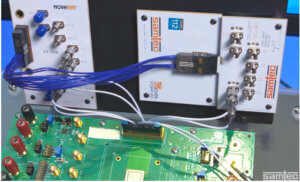
This demo, a collaboration between Samtec and Alphawave, emulates next generation data center equipment architectures, and incorporates Samtec Flyover® to improve signal integrity and architectural flexibility. Samtec Flyover routes critical high-speed signals from the ASIC, above lossy PCB materials, directly to the panel, utilizing ultra-low-skew twinax cable.
BERs of ~3E-9, pre-FEC, are incredible achievements at these data rates (the Alphawave AlphaCORE-100 MSS SerDes generates two lanes of 31-bit, PRBS data at 112 Gbps PAM4 data rates). The scatter plots and histograms are even, and the slicer output and noise margins are solid. This demonstration illustrates the advantages of Samtec Flyover.
Direct Connect To The Silicon Package
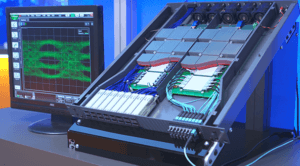
Samtec Direct Connect™ technology enables 56 Gbps PAM4 and 112 Gbps PAM4 systems. With Direct Connect, Samtec Flyover® cable assemblies plug directly into the chip package. This is an enabler for many other technologies. Advantages of Direct Connect include:
- Increased density in a smaller footprint allows for higher data rate density.
- Optical and copper connectivity in the same connector provides flexibility in choosing the appropriate solution for your application (a future-proof approach).
- The signal channel eludes the BGA trace breakout region and offers a 5x increase in reach.
Recently introduced Si-Fly is a new 112 Gbps PAM4, low-profile, high-density cable system. The contact design, extreme density, low profile, and on-package Direct Connect technology enables chip package aggregate data rate of 25.6 TB, with a path to 51.2 TB. Using this architecture as a reference, the IEEE 802.3CK IL spec limits the reach of high speed PCB substrates to 4.5”. However, Samtec Si-Fly and ultra low skew twinax enables 22” of reach before approaching the IEEE 802.3CK IL spec limits.
Cable Backplane For 112 Gbps PAM4 Architecture
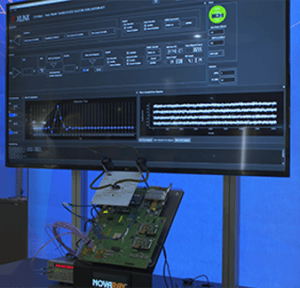
Scott McMorrow, CTO of Samtec’s Signal Integrity Group, walks us through a live demonstration of a cable backplane and mid-board cable system. Samtec Flyover is most commonly used in mid-board applications, with the cable assembly connector placed close to the chip and direct the signal to the front panel through the cable. Flyover also allows designers to go from one board to another as a flexible backplane architecture within a rack, as well as being used as a rack-to-rack interconnect. The traditional backplane architecture is retained, but the system offers lower PCB complexity while achieving higher performance targets.
Here’s a few links to learn more about Samtec high-bandwidth product families:

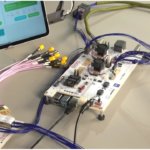
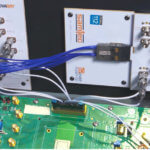
Leave a Reply